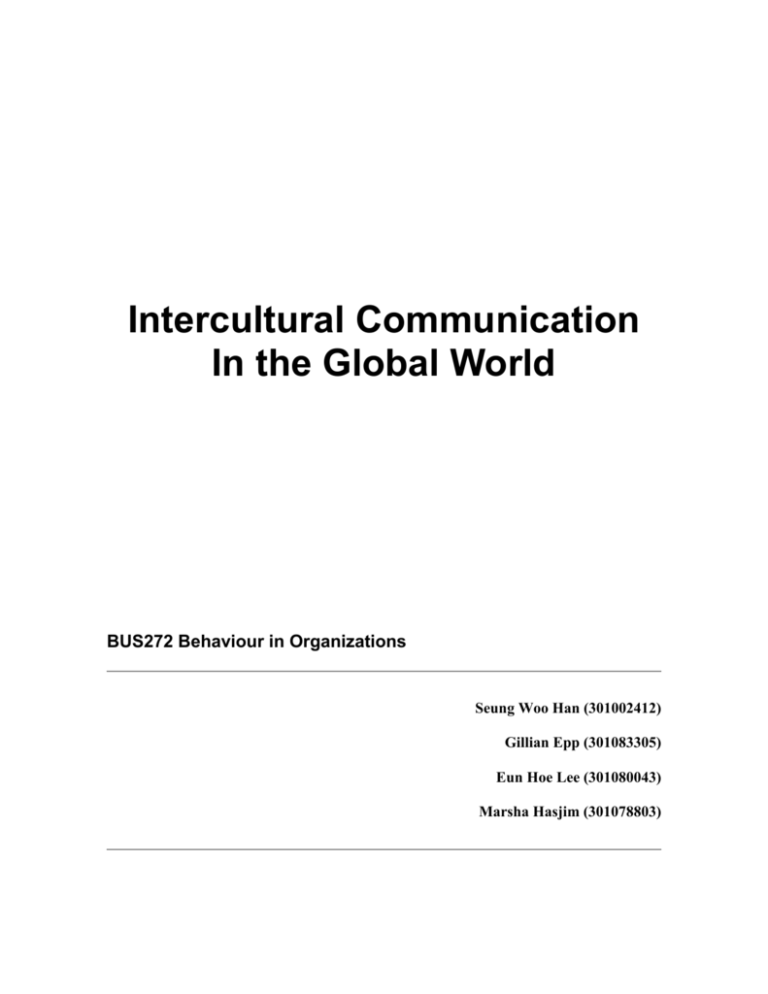
Intercultural Communication
In the Global World
BUS272 Behaviour in Organizations
Seung Woo Han (301002412)
Gillian Epp (301083305)
Eun Hoe Lee (301080043)
Marsha Hasjim (301078803)
Table of contents
TABLE OF CONTENTS .................................................................................................... 1
INTRODUCTION .............................................................................................................. 2
POWER: HIERARCHICAL VS. DEMOCRATIC CULTURES ................................... 3
SOCIAL FRAMEWORK: HIGH-CONTEXT VS. LOW-CONTEXT CULTURES ..... 6
NON-VERBAL COMMUNICATION .............................................................................. 8
TIME: LINEAR, FLEXIBLE, OR CYCLICAL ............................................................. 9
ELECTRONIC COMMUNICATION .............................................................................. 9
CONCLUSION ................................................................................................................. 11
APPENDIX........................................................................................................................ 12
BIBLIOGRAPHY ............................................................................................................. 12
1
Introduction
Communication is the process of creating and sharing information with one another.
Rapid changes in technology, transportation and immigration are making the world into a
small-intersected community, where understanding how different cultures communicate is
extremely important. In order to achieve effective intercultural communication we have to
understand how different cultures communicate.
Communication styles differ by how power is distributed within an organization.
There are essentially two types: hierarchical, and democratic. In a hierarchical structure the
most power is held by the highest ranking individual, where as in a democratic structure,
power distribution is uniformed among the individuals.
Edward T. Hall (1976) originated the classification of high-context versus lowcontext cultures, based on the amount of information that is implied versus stated directly
in a communication message. In high-context cultures, the meanings of the messages are
found in the situation and in the relationships of the communicators, or are internalized in
the communicator’s beliefs, values, and norms. In low-context cultures, less emphasis is
placed on the context. Instead they rely on explicit verbal messages. Understanding these
differences is essential to accurately decoding the message.
Communication specialists estimate that three-fourths of our communication is
nonverbal and takes place through our behavior. Nonverbal cues serve as the markers of
ones’ identities. The way people dress, the accent pattern, and the nonverbal way of
gesturing, all deliver messages to others.
2
A culture’s perception of time can alter the message being communicated. In a
culture that uses linear time, tasks are sequential. The focus is on the task to be completed
within a certain framework. Cultures that view time as flexible, are reluctant to strictly
measure or control it. They value relationships over schedules. The focus is on the present.
In cyclical time cultures; time manages life and humans must adjust to time. In these
cultures, time is viewed as cyclical, circular, and repetitive. The human being does not
control time; The cycle of life controls people and they must live in harmony with nature
and subscribe to the cyclical patterns of life. Examples of cyclical time cultures include
most Asian, African, and Native American cultures. Cultural concepts of time represent
strong normative forces affecting the behaviours and cognitions of the communicators.
The past decade has brought many advances in technology. These advances are
affecting the way cultures communicate and do business. Nowadays, it is not possible to
study communication without examining electronic communication.
To examine intercultural communication, four countries from four continents have
been selected: Canada, Brazil, Germany and Japan. The study of these differences and
similarities in communication will help people to work and socialize in the global world.
Power: Hierarchical vs. Democratic Cultures
Communication is directly correlated with culture. Most North American
businesses have relatively democratic organizational patterns; they allow a free flow of
information. “No matter what their job descriptions, workers in more democratic cultures
3
may consider themselves colleagues with differing levels of responsibility.” (Sana
ReynoldsDeborah, 2004) North American organizations do not distinguish people by ranks
or jurisdiction and respect equality. Information flows freely; communication flows both
upward and downward in democratic cultures. Ideas, suggestions, and complaints are sent
to anyone by anybody in companies that allow free information flow. Ideas, suggestions,
and complaints are sent to anyone by anyone and both upward and downward directions
within an organization.
In Brazil, individualism is upheld by hardship in the economy, creating a social
hierarchy that does not respect the rules of equality found in democratic frameworks, like
that of Canada. Brazil is aristocratic in its culture and politics. People of "high rank"
maintain an authoritative distance. In business decisions are made by the highest ranking
individual. This steep hierarchy discourages input from those at lower levels to those at
higher levels. Furthermore, information slows down as it moves up the levels of authority
eventually reaching the decision maker who is overloaded with information. On the way
down, information moves quickly.
Japan is also observed to have a hierarchical organizational structure. “The
Japanese prefer a strict hierarchy in their organizations, and that promotion in Japanese
government and businesses is usually based on seniority.” (Sana ReynoldsDeborah, 2004)
The Japanese culture’s preference for a clearly defined hierarchy is closely related
to the Confucian thought. Japanese believe that clarifying who is in charge is a good way to
preserve harmony; therefore, organizational situations where there is a defined hierarchy
4
are more comfortable. To those from Confucian cultures, losing face—personal dignity, can
be devastating and involves not only embarrassment but also profound shame. Furthermore,
in a collectivistic culture—Japan, one’s loss of face brings shame on the entire organization.
Thus, knowing the lines of power and authority by maintaining a clear hierarchy helps
people keep their face. Confucian beliefs strictly define the duties and responsibilities of
relationships that are inherently unequal. These cultures are comfortable with a clear
hierarchy in business, government, religion, and family life.
Germany also respects authority and hierarchical differences. Germans are
autocrats, who prefer formal communication when conducting business. Autocratic leaders
give order in a certain manner, which shows directness and straightforwardness. This is
called The Eiffel Tower Culture as orders come from the top to the bottom.
Brazil, Japan, and Germany prefer a hierarchical organizational structure because it
avoids uncertainty. Power is ensured within the organization. However, this hierarchy can
cause concealment and misrepresentation of information.
In non-hierarchical cultures—democratic cultures such as Canada, everyone shares
an equal amount of information and information it flows without limits. This free flow of
information can cause confusion throughout the organization. Therefore, the democratic
communication structure requires further training of job responsibility to ensure effective
communication.
5
Social Framework: High-Context vs. Low-Context Cultures
Culture is distributed in two major groups: high-context and low-context. Canada
is a low-context culture. Canadian managers rely heavily on memoranda, announcements,
position papers, and other formal forms of communication to state their positions on issues.
Canadian supervisors may hoard information in an attempt to make them look professional
and as a way of persuading their employees to accept decisions and plans.
Germany like many other European countries is also a low-context culture.
Individualism reflects the philosophical meaning, which is having the sense of achieving
one’s goal in order to provide good for the community. Germany observes little social
hierarchy in the organization as they focus on their personal achievements. Truth and
directness are important aspects in business, therefore criticism and other strong comments
are not considered as personal disapproval. They believe that they solve their problem by
explicitly speak up their thoughts. As the result of their directness, confrontations among
workers can result in a better outcome.
Collectivistic cultures, such as Japan, are often high-context cultures. These
cultures emphasize nonverbal communication and subtleness in communication rather than
being frank. High-context cultures are extremely polite, which fits with the indirect, subtle
nature of interpersonal
communication.
Ambiguity and obscurity characterized
conversations in a high-context culture. One purpose of this style of communication is to
avoid threatening the face of one’s conversation partner, thus bringing shame upon oneself.
What is not said may be more important than what is said.
6
Collectivism and interdependent self-construal in Japan promote the need for
verbal circumspection, and verbal circumspection often promotes face preservation and
relational harmony.
Brazilians as well prefer high-context communication, rich in non-verbal cues, that
takes place in person. They focus on personal relationships. In accordance with highcontext communication, "Maybe" or "I will try" is understood as "No" in Brazilian culture.
Brazil is a land of paradox, where reality is often not what it appears to be. There
are distinct differences between classes and race. When communicating, Brazilians seek
emotional connections with others.
In high-context communication, the listener or interpreter of the message is
expected to read “between the lines,” to accurately infer the implicit intent of the verbal
message, and to observe the nonverbal nuances and subtleties that encircle or “wrap” the
verbal message. In contrast, low-context cultures read the message itself.
Conflict is less common in high-context society than low-context. The emphasis is
on the group instead of the individual, reducing interpersonal friction. As well an elaborate
set of standards emphasize “obligations” over “rights”, what one owes to others rather than
deservers for oneself. The value attached to harmony cultivates skill in the use of ambiguity,
circumlocution, euphemism, and silence in blunting incipient disputes. The ability to
assimilate differences, to engineer consensus, is valued above a talent for argument in highcontext cultures.
7
Non-verbal Communication
Non-verbal communication is important. It includes eye contact, facial expression,
and gestures. North Americans use eye contact in one-to-one conversations, indicating
interest and respect. Body gestures meanings differ by culutre. In North America, if a
person nods by moving his head up and down, it means “yes”. The same gesture in Kuwait
is understood as “no”.
In Germany and North America, shaking hands at the beginning and the end of a
business meeting is important. In addition to a handshake, In Germany, a handshake may be
accompanied Germans,
bow and maintain strong eye contact when acknowledging
associates.
Brazilians, who are religious, emotional, and mystical people, think of the body as
the sender of messages. Understanding non-verbal clues is essential to understanding what
is being said. Personal space is not emphasized in Brazil. It is common for people engaged
in conversation to stand less than a foot apart and it would be considered rude to take a step
backwards.
In a Brazilian office people come in and out, and several conversations are carried
on at once. People do not take turns speaking. One might interrupt conversation or speak
simultaneously. This is not considered inappropriate. Brazilians also tend to linger in
silence for long periods of time, a custom that makes Canadians uncomfortable.
The value of talk versus silence in a conversation varies greatly depending on the
culture. For instance, in comparison to European and Americans, Asians are much more
8
taciturn, or reluctant to talk. An Asian is more likely to use indirect expression to convey an
intended meaning. Silence itself may be a very important message. For the Japanese, the
silence between two utterances in a conversation belongs to the previous speaker, who
indicates how long the silence should continue. The listener should show respect to the
previous speaker’s wish for silence, especially if the speaker is older or of higher status
than the listener. (Barnlund.Dean, 1989)
Unlike verbal communication, non-verbal communication is very unique among
cultures. For effective intercultural communication, using approrpiate non-verbal
communication is even more critical than just using a fluent foreign language.
Time: Linear, Flexible, or Cyclical
In Brazil, a flexible time culture, keeping a schedule is less important the human
feelings. When relationships require attention, time becomes a subjective commodity that
can be manipulated or stretched. Meetings are never rushed or cut short because of time
constraints in stead Brazilians live fully in the present.
Electronic Communication
Canada’s technology has improved in parallel with U.S. The role of electronic
communication in Canada has also grown significantly. Canadian organizations use
teleconferencing, which allows them to deliberate simultaneously, from anywhere, using
telephone or e-mail group communications software. Electronic data interchange is a way
for organization to exchange standard business transaction documents using direct
9
computer-to computer networks. Video conferencing is an alternative to travel.
In contrast, Brazil is an oral culture. Face-to-face, oral communication is preferred
over electronic communication. It is common and expected, that any electronic
communication is confirmed with a rendezvous.
Electronic communication is very common in Japan. Japan is one of the world's
most electronically connected information societies. They lead in rankings of: the Internet
use, the Internet penetration, broadband penetration, mobile phone ownership, 3G mobile
telecoms, WiFi hotspots and WiBro (Mobile WiMax) coverage. The economy from
television to advertising to banking to the automobile sector has embraced wireless
broadband connectivity offering everything from digital broadcast TV to handhelds and
cars, to over half of Japan using payment systems on their mobile phones.
(Something more) Germany also relies heavily on electronic communication. They
like the increased productivity and efficiency derived from modern communication tools.
Germany is constantly developing innovation in their world of electronic communication.
The German government plans to wiretap all electronic communications such as mobile,
emails, and Internet traffic. Such innovation shows how important and valuable electronic
communication is to Germany.
(Last paragraph about electronic communication)
Electronic Communication is facilitating globalization. It allows us to
communicate across water and masses simultaneously. Keeping the whole world in-touch.
The face of communication is ever changing. With great nations such as Germany, Japan,
and Canada relying heavily on electronic means of communications we can expect other
10
countries such as Brazil to soon follow.
Conclusion
Canada, Germany, Brazil, and Japan each have unique communication styles. They
differ in how they approach power, social framework, and non-verbal communication.
Brazil and Japan are collective countries while Germany and Canada are individual. People
in collective cultures are dependent one each other and are more productive when working
as a team. On the other hand, people in individual cultures work independently on tasks.
The role of time differs in each country. Brazil applies flexible time, Japan cynical
time, and Germany and Canada apply linear time. For Germany and Canada, are both low
context countries, yet they perceive power differently. Comparisons and contrasts of the
four countries of the four aspects can be found in the table below. Relationship and social
framework are tightly intertwined. High context cultures have collective values, while low
context cultures have individualist values. These four affect communication.
Communication itself is an exchange of information between senders and receivers,
and thus, people easily refer it as a simple matter. However, communication is very
complex and high-technological context to understand and to use. This complex context
becomes more complicated when cultures differ. Different cultures have different ways of
communicating. Through the understanding of how these cultures communicate, effective
inter-cultural communication can be achieved.
11
Appendix A
Country
Relationship Social Framework Time
Brazil
Collective
High Context
Flexible Hierarchical
Japan
Collective
High Context
Cyclical Hierarchical
Germany Individual
Low Context
Linear
Hierarchical
Individual
Low Context
Linear
Democratic
Canada
Power
Bibliography
HouseJ. (2006). Communicative styles in English and German. “EUROPEAN
JOURNAL OF ENGLISH STUDIES”, 249-267.
Barnlund.C.Dean. (1989). “Communicative styles of Japanese and Americans :
images and realities.” Belmont, Calif.: Wadsworth Pub. Co.
BurgoonK.Judee. (1995). “Nonverbal Communications: The Unspoken Dialogue.”
Boston: Mcgraw-Hill College.
Everett M. Rogers, T. M. (1999). Intercultural communication. Prospect Heights,
12
Ill.: Waveland Press, Inc.
KimYunYoung. (1988). “Communication and cross-cultural adaptation : an
integrative theory.” Clevedon [England]: Philadelphia : Multilingual Matters Ltd.
NovingerTracy. (2003). “Communicating with Brazilians : when "yes" means
"no".” Austin: University of Texas Press, 2003.
Sana
ReynoldsValentineDeborah.
(2004).
“Guide
to
cross-cultural
communication.” Upper Saddle River, N.J.: Pearson Prentice Hall.
Ting-ToomeyStella. (1999). “Communicating across cultures.” New York :
Guilford Press.
The International Business Etiquette Internet Sourcebook. Agri-Food Trade Service.
Retrieved July 28, 2008, from http://atn-riae.agr.ca/export/4027_e.htm
BeerE.Jennifer. (2003). High and Low Context. Communicating Across Cultures.
Retrieved July 28, 2008, from http://www.culture-at-work.com/highlow.html
GorrillR.Jodie. (2007). Doing Business in Germany | German Social and Business
Culture. Culture and Communication Skills Consultancy. Retrieved July 28, 2008, from
13
http://www.communicaid.com/%5Ccross-cultural-training%5Cculture-for-business-andmanagement%5Cdoing-business-in%5CGerman_business_culture.php
Lars. (2007). All electronic communication in Germany will be wiretapped in 2008.
Better than real. Retrieved July 28, 2008, from http://www.plasticboy.de/?p=17
PriestMatt. (1998). German Business Etiquette, Manners, Cross Cultural
Communication, and Geert Hofstede. German Business Etiquette, Manners, Cross Cultural
Communication, and Geert Hofstede. Retrieved July 28, 2008, from
http://www.cyborlink.com/besite/germany.htm
14









